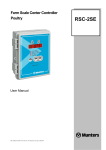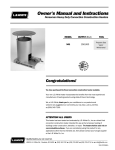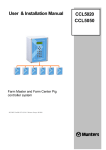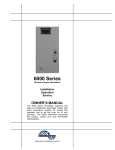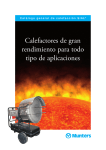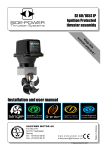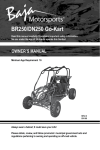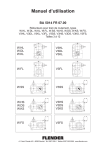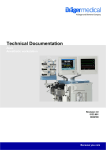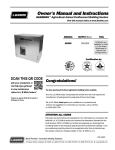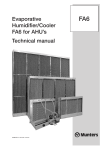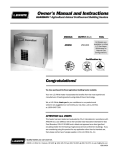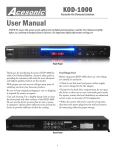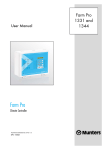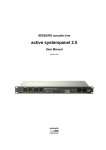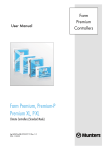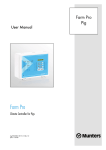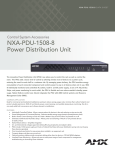Download User Manual
Transcript
User Manual GB65 GB65 Air Heater HC/MSA/UmGB-1589-08/09, ©Munters Europe AB 2008 GB65 Disclaimer Munters reserves the right to make alterations to specifications, quantities, dimensions etc. for production or other reasons, subsequent to publication. The information contained herein has been prepared by qualified experts within Munters. While we believe the information is accurate and complete, we make no warranty or representation for any particiular purposes. The information is offered in good faith and with the understanding that any use of the units or accessories in breach of the directions and warnings in this document is at the sole discretion and risk of the user. Agricultural Confinement Building Heaters Agricultural confinement building heaters are intended only for installation in farm buildings used for confignment of poultry and livestock and which are not used as human workplaces for periods in excess of 4 hours per day. This type of heater is not intended for use in other types of buildings including those used for human dwelling, grain storage or grain handling or where gasoline or other liquids having flammable vapors are stored or used. Refer to the ventilation requirements for agricultural confinement buildings in this manual. Agricultural Building Heaters Agricultural building heaters are intened only for installation in farm buildings excluding those used for human dwelling, grain storage or grain handling, or where gasoline or other liquids having flammable vapors are stored or used. Refer to the ventilation requirements for agricultural building heaters in this manual. HC/MSA/UmGB-1589-08/09 ©Munters Europe AB 2008 User Manual GB65 Munters reserves the right to make alterations to specifications, quantities, etc. for production or other reasons, subsequent to publication. 1(1) GB65 Table of Contents PAGE SECTION General Information . . . . . . . . . . . . . . . . . . . . . . . . . . . . . . . . . . . . . . . . . . . . . . . . . . . . . . . . . . . . . . . . . . .3 Heater Specifications . . . . . . . . . . . . . . . . . . . . . . . . . . . . . . . . . . . . . . . . . . . . . . . . . . . . . . . . . . . . . . . . . .4 Safety Precautions . . . . . . . . . . . . . . . . . . . . . . . . . . . . . . . . . . . . . . . . . . . . . . . . . . . . . . . . . . . . . . . . . . . .5 Installation Instructions General . . . . . . . . . . . . . . . . . . . . . . . . . . . . . . . . . . . . . . . . . . . . . . . . . . . . . . . . . . . . . . . . . . . . . . . . .7 Air Diverter Installation Instructions . . . . . . . . . . . . . . . . . . . . . . . . . . . . . . . . . . . . . . . . . . . . . . . . . .9 Hanging Instructions . . . . . . . . . . . . . . . . . . . . . . . . . . . . . . . . . . . . . . . . . . . . . . . . . . . . . . . . . . . . . . .9 Sediment Trap Assembly . . . . . . . . . . . . . . . . . . . . . . . . . . . . . . . . . . . . . . . . . . . . . . . . . . . . . . . . . .10 Thermostat Installation . . . . . . . . . . . . . . . . . . . . . . . . . . . . . . . . . . . . . . . . . . . . . . . . . . . . . . . . . . .10 Manual Shut-Off Valve, Hose and Regulator Assembly . . . . . . . . . . . . . . . . . . . . . . . . . . . . . . . . . .10 Start-Up Instructions . . . . . . . . . . . . . . . . . . . . . . . . . . . . . . . . . . . . . . . . . . . . . . . . . . . . . . . . . . . . . . . . .11 Shut-Down Instructions . . . . . . . . . . . . . . . . . . . . . . . . . . . . . . . . . . . . . . . . . . . . . . . . . . . . . . . . . . . . . . .11 Cleaning Instructions . . . . . . . . . . . . . . . . . . . . . . . . . . . . . . . . . . . . . . . . . . . . . . . . . . . . . . . . . . . . . . . . .12 Maintenance Instructions . . . . . . . . . . . . . . . . . . . . . . . . . . . . . . . . . . . . . . . . . . . . . . . . . . . . . . . . . . . . .12 Service Instructions General . . . . . . . . . . . . . . . . . . . . . . . . . . . . . . . . . . . . . . . . . . . . . . . . . . . . . . . . . . . . . . . . . . . . . . . .13 Motor and Fan Wheel Assembly . . . . . . . . . . . . . . . . . . . . . . . . . . . . . . . . . . . . . . . . . . . . . . . . . . . .13 Air Proving Switch with Paddle . . . . . . . . . . . . . . . . . . . . . . . . . . . . . . . . . . . . . . . . . . . . . . . . . . . . . .14 Igniter . . . . . . . . . . . . . . . . . . . . . . . . . . . . . . . . . . . . . . . . . . . . . . . . . . . . . . . . . . . . . . . . . . . . . . . . . .14 Flame Sensor . . . . . . . . . . . . . . . . . . . . . . . . . . . . . . . . . . . . . . . . . . . . . . . . . . . . . . . . . . . . . . . . . . .14 Replacing Gas Control Valve . . . . . . . . . . . . . . . . . . . . . . . . . . . . . . . . . . . . . . . . . . . . . . . . . . . . . . .15 Testing the Manual Reset High Limit Switch . . . . . . . . . . . . . . . . . . . . . . . . . . . . . . . . . . . . . . . . . . .15 Gas Pressure Checks . . . . . . . . . . . . . . . . . . . . . . . . . . . . . . . . . . . . . . . . . . . . . . . . . . . . . . . . . . . . .16 Troubleshooting Guide . . . . . . . . . . . . . . . . . . . . . . . . . . . . . . . . . . . . . . . . . . . . . . . . . . . . . . . . . . . . . . . .17 Electrical Connection and Ladder Diagram . . . . . . . . . . . . . . . . . . . . . . . . . . . . . . . . . . . . . . . . . . . . . . .24 Heater Component Function . . . . . . . . . . . . . . . . . . . . . . . . . . . . . . . . . . . . . . . . . . . . . . . . . . . . . . . . . . .25 Parts Identification Parts Schematic . . . . . . . . . . . . . . . . . . . . . . . . . . . . . . . . . . . . . . . . . . . . . . . . . . . . . . . . . . . . . . . . .26 Parts List . . . . . . . . . . . . . . . . . . . . . . . . . . . . . . . . . . . . . . . . . . . . . . . . . . . . . . . . . . . . . . . . . . . . . . .27 Warranty Policy . . . . . . . . . . . . . . . . . . . . . . . . . . . . . . . . . . . . . . . . . . . . . . . . . . . . . . . . . . . . . . . . . . . . .28 Replacement Parts and Service . . . . . . . . . . . . . . . . . . . . . . . . . . . . . . . . . . . . . . . . . . . . . . . . . . . . . . . .28 General Information This Owner's Manual includes all options and accessories commonly used on this heater. However, depending on the configuration purchased, some options and accessories may not be included. When calling for technical service assistance, or for other specific information, always have model number and serial number available. This information is contained on the dataplate. The dataplate is located on the exterior of the case assembly on the blower outlet side of the heater. This manual will instruct you in the operation and care of your unit. Have your qualified installer review this manual with you so that you fully understand the heater and how it functions. HC/MSA/UmGB-1589-08/09 ©Munters Europe AB 2008 The gas supply line installation, installation of the heater, and repair and servicing of the heater requires continuing expert training and knowledge of gas heaters and should not be attempted by anyone who is not so qualified. See page 6 for definition of the necessary qualifications. Contact your local MUNTERS distributor or MUNTERS for assistance, or if you have any questions about the use of the equipment or its application. MUNTERS has a policy of continuous product improvement. It reserves the right to change specifications and design without notice. User Manual GB65 Munters reserves the right to make alterations to specifications, quantities, etc. for production or other reasons, subsequent to publication. 2(2) GB65 Heater Specifications Model GB65 SPECIFICATIONS Fuel Type Butane / Propane Gas Maximum Input (kW) 65.9 Ventilation Air Required to Support Combustion (m3/hr.) 1590 Inlet Gas Supply MAX Pressure Acceptable at the Inlet of the Heater for Purpose MIN. of Input Adjustment (mbar) 33.6 27.4 Burner Manifold Pressure (mbar) 20.0 Fuel Consumption Per Hour (kg) 4.73 Motor Characteristics Ball Bearing 408 WATTS 1290 RPM Electrical Supply (Volts/Hz/Phase) 230/50/1 Amp Draw (Starting Amps Includes Igniter) STARTING 6.0 CONTINUOUS OPERATION 1.7 Dimensions L x W x H (cm) 93 x 61 x 51 Minimum Safe Distances From Nearest Combustible Materials HC/MSA/UmGB-1589-08/09 ©Munters Europe AB 2008 TOP SIDES BACK BLOWER OUTLET 0.3 m. 0.3 m. 0.3 m. GAS SUPPLY 1.83 m. 3.0 m. User Manual GB65 Munters reserves the right to make alterations to specifications, quantities, etc. for production or other reasons, subsequent to publication. 3(3) GB65 Safety Precautions ● ● ● ● ● ● ● ● ● ● ● GENERAL HAZARD WARNING Failure to comply with the precautions and instructions provided with this heater, can result in: — Death — Serious bodily injury or burns — Property damage or loss from fire or explosion — Asphyxiation due to lack of adequate air supply or carbon monoxide poisoning — Electrical shock Read this Owner’s Manual before installing or using this heater. Only properly-trained service people should repair or install this heater. Save this Owner’s Manual for future use and reference. Owner’s Manuals and replacement labels are available at no charge. WARNING Proper gas supply pressure must be provided to the inlet of the heater. Refer to the heater’s dataplate for proper gas supply pressure. Gas pressure in excess of the maximum inlet pressure specified at the heater inlet can cause fires or explosions. Fires or explosions can lead to serious injury, death, building damage or loss of livestock. Gas pressure below the minimum inlet pressure specified at the heater inlet may cause improper combustion. Improper combustion can lead to asphyxiation or carbon monoxide poisoning and therefore serious injury or death to humans and livestock. IMPORTANT INSTRUCTIONS ● ● ● ● ● ● ● Supply Cords must be placed or protected so it is not accessible to animals. Damaged appliances shall not be used Heat-radiating appliances shall not be mounted less than 500mm from animals or inflammable material Repairs shall be carried out only be a qualified Munters Technician. Upon installation, a plug for the disconnection of appliance from main supply must be provided. If the supply cord is damaged, it must be replaced by a qualified Munters Technician to avoid a hazard. FOR YOUR SAFETY Do not store or use gasoline or other flammable vapors and liquids in the vicinity of this or any other appliance. - Open windows. - Don't touch electrical switches. - Extinguish any open flame. - Immediately call your gas supplier. WARNING (Fire and Explosion Hazard) ● ● ● ● ● ● ● ● ● Not for home or recreational vehicle use. Installation of this heater in a home or recreational vehicle may result in a fire or explosion. Fire or explosions can cause property damage or loss of life. Keep solid combustibles a safe distance away from the heater. Solid combustibles include wood or paper products, feathers, straw, and dust. Do not use the heater in spaces which contain or may contain volatile or airborne combustibles. Volatile or airborne combustibles include gasoline, solvents, paint thinner, dust particles or unknown chemicals. Failure to follow these instructions may result in a fire or explosion. Fire or explosions can lead to property damage, personal injury or loss of life. HC/MSA/UmGB-1589-08/09 ©Munters Europe AB 2008 User Manual GB65 Munters reserves the right to make alterations to specifications, quantities, etc. for production or other reasons, subsequent to publication. 4(4) GB65 WARNING Asphyxiation Hazard ■ Do not use this heater for heating human living MUNTERS to determine combustion air ventilation quarters. requirements of the heater. ■ Do not use in unventilated areas. ■ The flow of combustion and ventilation air must not be obstructed. ■ Lack of proper ventilation air will lead to improper combustion. ■ Proper ventilation air must be provided to support the combustion air requirements of the heater being used. ■ Improper combustion can lead to carbon monoxide poisoning in humans leading to serious injury or death. Symptoms of carbon monoxide poisoning can include headaches, dizziness and difficulty in breathing. ■ Refer to the specification section of the heater’s Owner’s Manual, heater dataplate, or contact the ■ Symptoms of improper combustion affecting livestock can be disease, lower feed conversion, or death. FUEL GAS ODOR LP gashas a man-made odorant added specifically for detection of fuel gas leaks. If a gas leak occurs, you should be able to smell the fuel gas. THAT’S YOUR SIGNAL TO GO INTO IMMEDIATE ACTION! ■ Do not take any action that could ignite the fuel gas. Do not operate any electrical switches. Do not pull any power supply or extension cords. Do not light matches or any other source of flame. Do not use your telephone. ■ Get everyone out of the building and away from the area immediately. ■ Close all propane gas tank or cylinder fuel supply valves. ■ Propane gas is heavier than air and may settle in low areas. When you have reason to suspect a propane leak, keep out of all low areas. ■ Use your neighbor’s phone and call your fuel gas supplier and your fire department. Do not re-enter the building or area. ■ Stay out of the building and away from the area until declared safe by the firefighters and your fuel gas supplier. ■ FINALLY, let the fuel gas service person and the firefighters check for escaped gas. Have them air out the building and area before you return. Properly trained service people must repair the leak, check for further leakages, and then relight the appliance for you. ODOR FADING -- NO ODOR DETECTED ■ Some people cannot smell well. Some people cannot smell the odor of the man-made chemical added to propane (LP) gas. You must determine if you can smell the odorant in this fuel gas. ■ Learn to recognize the odor of propane gas. Local propane gas dealers will be more than happy to give you a scratch and sniff pamphlet. Use it to become familiar with the fuel gas odor. ■ Smoking can decrease your ability to smell. Being around an odor for a period of time can affect your sensitivity to that particular odor. Odors present in animal confinement buildings can mask fuel gas odor. ■ The odorant in propane gas is colorless and the intensity of its odor can fade under some circumstances. ■ If there is an underground leak, the movement of gas through the soil can filter the odorant. ■ Propane gas odor may differ in intensity at different levels. Since propane gas is heavier than air, there may be more odor at lower levels. ■ Always be sensitive to the slightest gas odor. If you continue to detect any gas odor, no matter how small, treat it as a serious leak. Immediately go into action as discussed previously. ATTENTION -- CRITICAL POINTS TO REMEMBER! ■ Propane gas has a distinctive odor. Learn to recognize this odor. (Reference Fuel Gas Odor and Odor Fading sections above. ■ Even if you are not properly trained in the service and repair of the heater, ALWAYS be consciously aware of the odor of propane gas. ■ If you have not been properly trained in repair and service of propane gas fueled heaters, then do not attempt to light heater, perform service or repairs, or make any adjustments to the heater on a propane gas fuel system. ■ A periodic sniff test around the heater or at the heater’s joints; i.e. hose, connections, etc., is a good safety practice under any conditions. If you smell even a small amount of gas, CONTACT YOUR FUEL GAS SUPPLIER IMMEDIATELY. DO NOT WAIT! HC/MSA/UmGB-1589-08/09 ©Munters Europe AB 2008 User Manual GB65 Munters reserves the right to make alterations to specifications, quantities, etc. for production or other reasons, subsequent to publication. 5(5) GB65 Safety Precautions 1. Do not attempt to install, repair, or service this heater or the gas supply line unless you have continuing expert training and knowledge of gas heaters. Qualifications for service and installation of this equipment are as follows: a. To be a qualified gas heater service person, you must have sufficient training and experience to handle all aspects of gas-fired heater installation, service and repair. This includes the task of installation, troubleshooting, replacement of defective parts and testing of the heater. You must be able to place the heater into a continuing safe and normal operating condition. You must completely familiarize yourself with each model heater by reading and complying with the safety instructions, labels, Owner’s Manual, etc., that is provided with each heater. b. To be a qualified gas installation person, you must have sufficient training and experience to handle all aspects of installing, repairing and altering gas lines, including selecting and installing the proper equipment, and selecting proper pipe and tank size to be used. This must be done in accordance with all local, state and national codes as well as the manufacturer’s requirements. 2. All installations and applications of MUNTERS heaters must meet all relevant local, state and national codes. Included are L.P. gas, natural gas, electrical, and safety codes. Your local fuel gas supplier, a local licensed electrician, the local fire department or similar government agencies, or your insurance agent can help you determine code requirements. 3. Do not move, handle, or service heater while in operation or connected to a power or fuel supply. 9. The hose assembly shall be visually inspected on an annual basis. If it is evident there is excessive abrasion or wear, or if the hose is cut, it must be replaced prior to the heater being put into operation. The hose assembly shall be protected from animals, building materials, and contact with hot surfaces during use. The hose assembly shall be that specified by the manufacturer. See parts list. 10. Check for gas leaks and proper function upon heater installation, before building repopulation or when relocating. 11. This heater should be inspected for proper operation by a qualified ser vice person before building repopulation and at least annually. 12. Always turn off the gas supply to the heater if the heater is not going to be used in the heating of livestock. 13. This heater is wired for a three-wire electrical system. There is a hot lead, neutral lead, and a ground lead. The heater may or may not incorporate a plug in the power cord on the heater and the plug may or may not incorporate a pin for the ground wire. In any case, the heater must be properly connected into a grounded electrical supply using the ground lead in the power cord. Failure to use a properly grounded electrical supply can result in electrical shock, personal injury, or death. 14. Electronic ignition heaters will make up to three trials for ignition. If ignition is not achieved after the third trial, the control system will lock out the gas control valve. If gas is smelled after system lock out has occurred, immediately close all fuel supply valves. Do not relight until you are sure that all as that may have accumulated has cleared away. In any event, do not relight the heater for at least 5 minutes. 4. This heater may be installed in areas subject to washdown. This heater may only be washed on the external case assembly—see Cleaning Instructions. Do not wash the interior of the heater. Use only compressed air, soft brush or dry cloth to clean the interior of the heater and it’s components. After external washdown, do not operate the heater until it is completely dry. In any event, do not operate this heater for at least one hour after external washdown. 15. In a hanging type installation, rigid pipe or copper tubing coupled directly to the heater may cause gas leaks during movement, and therefore must not be used. Use only gas hose assemblies that are rated and approved for LP-gas and natural gas in a hanging type installation. 5. For safety, this heater is equipped with manual reset high-limit switches and an air flow switch. Never operate this heater with any safety device that has been bypassed. Do not operate this heater unless all of these features are fully functioning. 16. Installations not using the gas hose supplied with this appliance must connect dimensionally using American National Standard Wrought Steel and Wrought Iron Pipe B36/10-1970. (Aluminum piping or tubing shall not be used.) Copper tubing when used for conveying natural gas, shall be internally tinned or equivalently treated to resist sulphur. 6. Do not operate the heater with its door open or panel removed. 7. Do not locate fuel gas containers or fuel supply hoses within 6.10 meters of the heater’s blower outlet. 8. Do not block air intakes or discharge outlets of the appliance. Doing so may cause improper combustion or damage to heater components leading to property damage or animal loss. HC/MSA/UmGB-1589-08/09 ©Munters Europe AB 2008 User Manual GB65 Munters reserves the right to make alterations to specifications, quantities, etc. for production or other reasons, subsequent to publication. 6(6) GB65 Installation Instructions GENERAL that valve to malfunction resulting in a serious gas leak that could result in a possible fire or explosion causing loss of products, building or even life. A properly installed sediment trap will keep foreign materials from entering the gas valve and protect the safe functioning of that important safety component. WARNING Fire or Explosion Hazard. Can cause property damage, severe injury or death. ■ Disconnect power supply before wiring to prevent electrical shock or equipment damage. ■ To avoid dangerous accumulation of fuel gas, turn off gas supply at the appliance service valve before starting installation, and perform gas leak test after completion of installation. ■ Do not force the gas control knob. Use only your hand to turn the gas control knob. Never use any tools. If the knob will not operate by hand, the control should be replaced by a qualified service technician. Force or attempted repair may result in fire or explosion. 1. Read all safety precautions and follow MUNTERS recommendations when installing this heater. If during the installation or relocating of heater, you suspect that a part is damaged or defective, call a qualified service agency for repair or replacement. 9. Any heater connected to a piping system must have an accessible, approved manual shut off valve installed within 1.83 meters of the heater it serves. 10. Check all connections for gas leaks using approved gas leak detectors. Gas leak testing is performed as follows: WARNING ■ ■ ■ ■ 2. Make sure the heater is properly positioned before use and is hung level. Observe and obey all minimum safe distances of the heater to the nearest combustible materials. Minimum safe distances are given on the heater nameplate and on page 4 of this manual. Fire and Explosion Hazard Do not use open flame (matches, torches, candles, etc.) in checking for gas leaks. Use only approved leak detectors. Failure to follow this warning can lead to fires or explosions. Fires or explosions can lead to property damage, personal injury or loss of life. -- Check all pipe connections, hose connections, fittings and adapters upstream of the gas controlwith approved gas leak detectors. -- In the event a gas leak is detected, check the components involved for cleanliness and proper application of pipe compound before further tightening. Furthermore tighten the gas connections as necessary to stop the leak. After all connections are checked and any leaks are stopped, turn on the main burner. Stand clear while the main burner ignites to prevent injury caused from hidden leaks that could cause flashback. With the main burner in operation, check all connections, hose connections, fittings and joints as well as the gas control valve inlet and outlet connections with approved gas leak detectors. If a leak is detected, check the components involved for cleanliness in the thread areas and proper application of pipe compound before further tightening. Tighten the gas connection as necessary to stop the leak. If necessary, replace the parts or components involved if the leak cannot be stopped. Ensure all gas leaks have been identified and repaired before proceeding. 3. This heater is approved for indoor use only. 4. The heater must have the proper gas regulator installed for the application. A regulator must be connected to the gas supply so that gas pressure at the inlet to the gas valve is regulated within the range specified on the dataplate at all times. Contact your gas supplier, or MUNTERS if you have any questions. -- 5. The heater’s gas regulator (with pressure relief valve) should be installed outside of building. Any regulators inside the buildings must be properly vented to the outside. Local, state and national codes always apply to regulator installation. Natural gas regulators with vent limiting device may be mounted indoors without venting to outdoors. -- 6. All gas pressure regulators must be installed in strict accordance with the manufacturer’s safety instructions. These instructions accompany each regulator. -- --- -- --- 7. Insure that all accessories that ship within the heater have been removed from inside of heater and installed. This per tains to air diver ters, hose, regulator, etc. 8. Make certain that a sediment trap is installed at the gas valve inlet to prevent foreign materials (pipe compound, pipe chips and scale) from entering the gas valve. Debris blown into the gas valve may cause HC/MSA/UmGB-1589-08/09 ©Munters Europe AB 2008 11. A qualified service agency must check for proper operating gas pressure upon installation of the heater. 12. Light according to instructions on the heater or within owner’s manual. User Manual GB65 Munters reserves the right to make alterations to specifications, quantities, etc. for production or other reasons, subsequent to publication. 7(7) GB65 13. Make sure the heater has the proper gas regulator for the application. A regulator must be connected to the gas supply so that gas pressure at the inlet to the gas valve is regulated within the range specified on the dataplate at all times. Contact your gas supplier, or, MUNTERS Heating, if you have any questions. 14. It is extremely important to use the proper size and type of gas supply line to assure proper functioning of the heater. Contact your fuel gas supplier for proper line sizing and installation. 15. This heater can be configured for use with either L.P. vapor withdrawal or natural gas. Consult the dataplate, located on the blower outlet side of the case assembly, for the gas configuration of the specific heater. Do not use the heater in an L.P. gas liquid withdrawal system or application. If you are in doubt, contact MUNTERS. building and also to the individual heater. Contact your fuel gas supplier if you have any questions. 18. Any defects found in performing any of the service or maintenance procedures must be eliminated and defective parts replaced immediately. The heater must be retested by properly qualified service personnel before placing the heater back into use. 19. Do not exceed input rating stamped on the dataplate of the heater. Do not exceed the burner manifold pressure stated on the dataplate. Do not use an orifice size different than specified for the specific input rating of this heater, fuel type configuration and altitude. 16. Eventually, like all electrical/mechanical devices, the thermostat can fail. Thermostat failure may result in either an underheating or overheating condition which may damage critical products and/or cause animal injury or death. Critical products and/or animals should be protected by a separate back-up control system that limits high and low temperatures and also activates appropriate alarms. 17. Take time to understand how to operate and maintain the heater by using this Owner’s Manual. Make sure you know how to shut off the gas supply to the HC/MSA/UmGB-1589-08/09 ©Munters Europe AB 2008 User Manual GB65 Munters reserves the right to make alterations to specifications, quantities, etc. for production or other reasons, subsequent to publication. 8(8) GB65 AIR DIVERTER INSTALLATION INSTRUCTIONS (Appearance of the outlet on heater may vary from model to model.) 1. Air diverters can be installed in the heater outlet to provide direction to the heated air as it exits the heater. Refer to Fig. 1. Air diverters can be installed to direct the air in either two 45 degree paths or in one 45 degree direction. FIG.1 (Typical installation allowing two directions of air movement.) NOTCHES IN MOUNTING TABS TABS 2. The air diverters may require hand forming prior to installation. Make 90 degree bends utilizing the perforations provided. The diverter halves should then have the shape as shown in Fig. 1. 3. The air diverter’s tabs on each half will pop into the blower outlet between the inside of the case assembly and the blower housing outlet. If the notched tabs do not pop into the blower outlet, loosen the blower outlet screws. Doing this provides a gap into which you can insert the tabs. Retighten the screws after installation. OUTLET SCREWS FORMED OUTLET GUARD DIVERTER HALVES ALTERNATE AIR DIVERTER ARRANGEMENTS HANGING INSTRUCTIONS 1. Assemble according to Fig.3 and tighten all eyebolts securely. 2. Be sure heater is securely fastened and is hanging level. (Check crosswise and lengthwise.) FIG. 2 NOTE: REGULATORS SHOULD ALWAYS BE MOUNTED OUTDOORS. IF CIRCUMSTANCES FORCE INSTALLING THE REGULATOR INDOORS, THE REGULATOR'S VENT MUST BE VENTED OUTDOORS USING VENT LINE NO SMALLER THAN VENT OPENING. 3. See Fig. 2 for typical indoor installation. In any animal confinement building, consideration must be given to making sure the heater is located away from the livestock so that livestock cannot knock the heater, tear it loose from its mounting, or damage the heater or its gas supply line in any way. Make sure you observe and obey minimum clearance distances to combustible materials as stated in the specification section of this owner’s manual and on the heater dataplate. FIG. 3 VENT OF REGULATOR MUST POINT DOWN AND REGULATOR MUST BE VENTED OUTDOORS CHA IN O MANUAL SHUT-OFF VALVE CAN BE INSTALLED BEFORE THE REGULATOR, UNDER THE EAVE OF THE BUILDING, OR AFTER THE REGULATOR INSIDE THE BUILDING. R CA BLE OPTIONAL INDOOR REGULATOR MOUNTING LOCATION BLACK PIPE THROUGH WALL GAS HOSE EYE BOLT THERMOSTAT CORD CHAIN VENT LINE WALL NUT HEATER FLAT WASHER AIR DIVERTER YOKE POWER CORD FLAT WASHER HEATER TOP NUT HC/MSA/UmGB-1589-08/09 ©Munters Europe AB 2008 THERMOSTAT WALL OUTLET 1 FT. User Manual GB65 Munters reserves the right to make alterations to specifications, quantities, etc. for production or other reasons, subsequent to publication. 1 FT. SEDIMENT TRAP 9(9) GB65 SEDIMENT TRAP ASSEMBLY Assemble the tee, nipples and cap together and tighten securely. The sediment trap assembly must always be mounted in a vertical position. Make sure pipe thread compound that is resistant to both L.P. and natural gas is used in making all connections. Check all connections for gas leaks using approved gas leak detectors. FIG. 4 NIPPLE HOSE ADAPTER TEE TO GAS CONTROL VALVE INLET NIPPLE CAP THERMOSTAT INSTALLATION a. The installation and wiring of a thermostat must be done by an electrician or someone properly qualified. WARNING Electrical Shock Hazard ■ Disconnect the electrical supply before connecting the thermostat to the heater. ■ Failure to follow this warning can result in electrical b. The thermostat may use 18 gauge, 3 wire (with ground) cord to handle the voltage being supplied to the thermostat. shock, leading to personal injury or death. 1. To Connect the Direct Wired Thermostat Kit to the Control Box on the Heater: c. The heater must be tested for proper operation after the thermostat has been connected. MANUAL SHUT-OFF VALVE, HOSE AND REGULATOR ASSEMBLY 1. Always use approved pipe thread compound suitable for use with L.P. or natural gas on the threaded connections. FIG. 5 VALVE, MANUAL SHUT-OFF NIPPLE 1/2" 2. Assemble the components together according to the figure. This view is to show general assembly of the components only. PIPING ADAPTER REGULATOR 3. Tighten all connections securely. 4. Check all connections for gas leaks using approved gas leak detectors. REGULATOR VENT PIPING ADAPTER GAS FLOW ADAPTER GAS HOSE ADAPTER TO GAS CONTROL SEDIMENT TRAP VALVE INLET HC/MSA/UmGB-1589-08/09 ©Munters Europe AB 2008 User Manual GB65 Munters reserves the right to make alterations to specifications, quantities, etc. for production or other reasons, subsequent to publication. 10(10) GB65 Start-Up Instructions Follow steps 1 - 6 on initial start-up after heater installation by a qualified gas heater service person. For normal startup, simply set the thermostat above room temperature. The heater will start. 1. Open all manual fuel supply valves and check for gas leaks using approved leak detectors. The gas control valve on the heater has a manual shut-off feature incorporated into the valve assembly and will be located within the gas control and electrical enclosure. Open the enclosure and make sure the indicator on the valve is turned to the “on” position. Close and latch the enclosure. See Fig. 6. emitting diode (LED). This LED indicates the status of the heater. The LED is visible external of the control enclosure through the plastic eye. A constant light from the LED is an indicator that the heater is functioning correctly. Any flash pattern by the LED is indicative that there is a problem in the operation of the heater. Refer to the troubleshooting decal on the access panel at the fan motor end of the heater for assistance in troubleshooting. Only qualified and properly trained personnel shall service or repair the heater. 5. FIG. 6 NOTE: It is normal for air to be trapped in the gas hose on new installations. The heater may attempt more than one trial for ignition before the air is finally purged from the line and ignition takes place. ON OFF 2. On a call for heat, the motor will start up and run for about 6 seconds and then stop. This “pre-purge” is a safety feature and a normal operational charactertistic prior to ignition taking place. After the motor has stopped, the lighter will heat up (approximately 30 seconds). After igniter warm up time has been achieved, the motor will start again and shortly thereafter ignition will occur. Connect the electrical cord to an approved electrical outlet. 3. Set the thermostat (if supplied) to desired room temperature. 4. This heater includes a direct ignition control module for purposes of controlling the timing of the ignition process of the heater as well as monitoring of the safety functions. The module is contained within the metal control box. On the module is a red light 6. The HSI control will make up to three trials for ignition. Each trial for ignition will take approximately 45 seconds. The first two trials for ignition will occur within 90 seconds if ignition is not achieved. A 15 minute wait period will then begin. After the 15 minute time span has elapsed, the control will make three more trials for ignition. If igntion is not achieved after after the final trial, the control system will “lock out” and the “three flash” light pattern will be indicated by the LED. Shut-Down Instructions If the heater is to be shut down for cleaning, maintenance or repair, follow steps 1 - 5. Otherwise, simply turn thermostat to off or no heat for standard shut down. 1. Close all manual fuel supply valves. 3. Turn the indicator on the gas control to off. 4. Turn thermostat to off or no heat position. 5. Disconnect the heater from the electrical supply. 2. With the heater lit, allow heater to burn off excess fuel in gas supply hose. HC/MSA/UmGB-1589-08/09 ©Munters Europe AB 2008 User Manual GB65 Munters reserves the right to make alterations to specifications, quantities, etc. for production or other reasons, subsequent to publication. 11(11) GB65 Cleaning Instructions WARNING Fire, Burn, and Explosion Hazard ■ This heater contains electrical and mechanical components in the gas management, safety and airflow systems. ■ Such components may become inoperative or fail due to dust, dirt, wear, aging, or the corrosive atmosphere of an animal confinement building. ■ Periodic cleaning and inspection as well as proper maintenance are essential to avoid serious injury or property damage. 1. Before cleaning, shut off all gas supply valves and disconnect the electrical supply. 2. The heater should have dir t or dust removed periodically: a. Af ter each flock or between building repopulation, give the heater a general cleaning using compressed air or a soft brush on its interior and exterior. At this time, dust off the motor case to prevent the motor from over-heating and shutting the heater down. b. At least once a year, give the heater a thorough cleaning. At this time, remove the fan and motor assembly and brush or blow off the fan wheel, giving attention to the individual fan blades. Make sure the burner air inlet venturi ports and the throat of the casting are free of dust accumulation and the area between the heat chamber top and inside case is also free of dust. Additionally, the flame sensor should be removed and cleaned according to the service instructions within this Owner’s Manual. c. When washing with water, observe and obey the Warning within these Cleaning Instructions. This same Warning is also supplied on the heater. WARNING This heater may be washed only on the external case assembly provided: A. The heater is disconnected from the electrical supply. B. All access panels are securely closed. C. Water spray nozzle shall not discharge within 1.83 m. of the heater. D. The water pressure does not exceed 3.1 bar for 10 seconds on each side of heater. E. The heater is not reconnected to electrical supply for a minimum of 1 hour or until the heater is thoroughly dry. Improper cleaning of the heater can cause severe personal injury or property damage due to water and/or cleaning solution: 1. In electrical components, connections and wires causing electrical shock or component failure. 2. On gas control components causing corrosion which can result in gas leaks and fire or explosion from the leak. Clean internal components of the heater with a soft, dry brush or cloth, or compressed air. Maintenance Instructions 1. Have your gas supplier check all gas piping annually for leaks or restrictions in gas lines. Also, at this time have your gas supplier clean out the sediment trap of any debris that may have accumulated. 2. The appliance area shall be kept clear and free from combustible materials, gasoline, and other flammable vapors and liquids. HC/MSA/UmGB-1589-08/09 ©Munters Europe AB 2008 3. Regulators can wear out and function improperly. Have your gas supplier check the date codes on all regulators installed and check delivery pressures to the appliance to make sure that the regulator is reliable. 4. Regulators must be periodically inspected to make sure the regulator vents are not blocked. Debris, insects, insect nests, snow, or ice on a regulator can block vents and cause excess pressure at the appliance. User Manual GB65 Munters reserves the right to make alterations to specifications, quantities, etc. for production or other reasons, subsequent to publication. 12(12) GB65 Service Instructions GENERAL WARNING Burn Hazard ■ Heater surfaces are hot for a period of time after the 4. The thermostat, and high limt switch can be tested by jumpering the suspect part out of the electrical circuit.: heater has been shut down. -- Reconnect the electrical supply and open fuel supply valves. ■ Allow the heater to cool before performing service, maintenance, or cleaning. -- If the heater lights, the component is defective and must be replaced. ■ Failure to follow this warning will result in burns causing injury. -- Do not operate the heater with the component jumpered. Replace the part immediately. WARNING -- An alternate method for checking the components is to perform a continuity check. Fire and Explosion Hazard ■ Do not disassemble or attempt to repair any heater components or gas train components. ■ All component parts must be replaced if defects are found. ■ Failure to follow this warning will result in fire or explosions, causing property damage, injury, or death. 1. Close the fuel supply valve to the heater and disconnect the electrical supply before servicing unless necessary for your service procedure. 2. Open side panels for access to heater components. 3 Disconnect the appropriate electrical leads for the component being replaced. 5. Do not jumper the air proving switch. If jumpered, the ignition control will not allow heater operation. Test the air proving switch for continuity. If defective, replace the switch 6. For reassembly, reverse the respective service procedure. Ensure gas connections are tightened securely. 7. After servicing, start the heater to ensure proper operation. Check for gas leaks with approved leak detectors. 8. Clean the heater’s orifice with compressed air or a soft, dry rag. Do not use files, drills, broaches, etc. to clean the orifice. Doing so may enlarge the hole, causing combustion or ignition problems. Replace the orifice if it cannot be cleaned properly. MOTOR AND FAN WHEEL ASSEMBLY 1. Remove the screws securing the motor mounting plate to the fan housing. -- Fan wheel to motor mount plate spacing must be adjusted to proper clearance before tightening the fan wheel to the motor shaft. 2. Pull the fan and motor assembly from the housing. -- Make sure that set screw(s) of the fan are on the “flats” of motor shaft when tightening. 3. Loosen the square head set screw(s) on the fan wheel with a wrench. Clearance 4.8 mm 4. Pull the fan wheel from the motor shaft. Use a wheel puller if necessary. FIG. 7 5 Remove the four (4) nuts securing the motor to the mounting plate. MOTOR MOUNT PLATE MOTOR HC/MSA/UmGB-1589-08/09 ©Munters Europe AB 2008 User Manual GB65 Munters reserves the right to make alterations to specifications, quantities, etc. for production or other reasons, subsequent to publication. FAN WHEEL CLEARANCE 13(13) GB65 AIR PROVING SWITCH WITH PADDLE 1. Remove the screws holding the switch assembly to blower housing side panel. FIG. 8 PADDLE NUTS 2. Remove switch assembly by turning it 90° so the paddle on the switch arm can be pulled through the oblong hole on side of fan housing. HO US ING SID EP AN EL SWITCH W/PADDLE LEADS OBLONG HOLE IGNITER ■ Do not overtighten the igniter. Overtightening can cause 1. See Fig. 9 for disassembly. cracks in igniter base, leading to failure. 2. Position the replacement igniter so its lip and mounting slot fit to slot and screw hole of igniter bracket. ■ Do not handle the igniter by its element. Handle the igniter by its ceramic base, or leads. 3. Reassemble remaining parts. 4. Tighten the mounting screw snugly. FLAME SENSOR Complete this procedure at least once during the heating season. 1. Remove the sensor from its mounting bracket. See Fig. 9. Clean the sensor rod with steel wool or emery cloth. Rub briskly to remove build up of dust, dirt and aluminum oxide. 2. Check the flame sensor’s insulator base for cracks. If cracks are found, replace the sensor. 3. Position the flame sensor as shown in Fig. 10. FIG. 10 FIG. 9 BURNER CASTING 12.7 to 19 1/2 TO 3/4cm IN. IGNITER BURNER FLAME FLAME SENSOR IGNITER SHIELD FLAME SENSOR LOCK WASHER SCREW BURNER CASTING IGNITER BRACKET MALE CONNECTOR SCREW WIRE HARNESS, FEMALE CONNECTOR HC/MSA/UmGB-1589-08/09 ©Munters Europe AB 2008 User Manual GB65 Munters reserves the right to make alterations to specifications, quantities, etc. for production or other reasons, subsequent to publication. 14(14) GB65 REPLACING GAS CONTROL VALVE 1. Remove the hose and sediment trap from the heater. FIG. 12 2. Refer to Figs. 11 and 12 for dissassembly. FIG. 11 REMOVE SCREWS LOOSEN UNION REMOVE FROM VALVE REMOVE FROM VALVE REMOVE SCREWS CONTROL BOX REMOVE SCREWS TESTING THE MANUAL RESET HIGH LIMIT SWITCH 3. Allow the switch cool down for about a minute before firmly pressing the red reset button on the switch. WARNING Fire Hazard ■ Do not operate the appliance with the high limit switch ■ bypassed. Operating the heater bypassed high limit switch may lead to overheating, possibly resulting in a fire, with subsequent damage to the heater, building damage, or loss of livestock. This heater has two high limit switches. One is located near the burner. The other is located on the fan housing at the opposite end of the heater. The high limit switches should be tested a minimum of once a year when the heater is given a thorough cleaning. The high limit switches have different temperature ratings. To eliminate confusion, remove and test only one high limit switch at a time. 4. Check for electrical continuity across the switch terminals to make sure the contacts have closed. 5. Reinstall the switch back into the heater. Reconnect the heater to its electrical supply. Start the heater and check for proper operation. FIG. 13 1. Holding the switch by one of its mounting legs or electrical terminals, apply a small flame only to the sensing portion on the back of the switch. Be careful not to melt the plastic housing of the switch when conducting this test. RESET BUTTON SENSING SURFACE TERMINAL MOUNTING LEG FLAME 2. Within a minute, you should hear a pop coming from the switch, indicating the contacts of the switch have opened. Check for lack of electrical continuity across the switch terminals to verify contacts have opened. HC/MSA/UmGB-1589-08/09 ©Munters Europe AB 2008 User Manual GB65 Munters reserves the right to make alterations to specifications, quantities, etc. for production or other reasons, subsequent to publication. 15(15) GB65 Gas Pressure Checks 3. Open the fuel supply valves to the heater and reconnect the heater electrical supply. ■ Do not attempt to replace any components of the gas 4. Start the heater C. Reading Pressures control valve. ■ The gas control valve must be replaced if any physical damage occurs to the control valve assembly. ■ Failure to follow this warning will result in fire or explosions, leading to injury or death to humans, and property damage. ■ The following explains a typical procedure to be followed in checking gas pressures. ■ The gas pressures will vary depending upon fuel type. ■ Consult the dataplate on the heater or page 4 in this manual for specific pressures to be used in conjunction with this procedure. ■ Gas pressure measured at the inlet to the gas valve is Inlet Pressure and gas pressure measured at the outlet of the gas valve is Burner Manifold Pressure. 1. With the heater operating, the pressure gauges should read the pressures specified on the dataplate. 2. Do the readings at the inlet and outlet pressure gauges agree with that specified on the dataplate? If so, then no further checking or adjustment is required. Proceed to section D. 3. If the inlet pressures do not agree with that specified on the dataplate, then the regulator controlling gas pressure to the heater requires adjustment. 4. If the inlet pressures are correct and the burner manifold pressure does not agree with that specifed on the dataplate, then the gas control valve’s internal pressure regulator requires adjustment. See Fig. 15 for regulator location. FIG. 15 INTERNAL PRESSURE REGULATOR 1. Obtain two pressure gauges capable of reading up to 65 mbar. OUTLET PRESSURE TAP LOW PRESSURE GAUGE 25 30 45 3. Open the burner access panel. 35 40 45 5 ON 5 0 LOW PRESSURE GAUGE 50 55 60 6 2. Disconnect the heater from the electrical supply and close the fuel supply valve to the heater inlet. 35 25 30 40 50 55 60 6 5 10 15 20 A. Preparation 5 10 15 20 ■ Do not disassemble the gas control valve. 0 WARNING OFF 4. Brush or blow off any dust and dirt on or in the vicinity of the gas control valve. INLET PRESSURE TAP B. Gauge Installation D. Completion 1. Locate the inlet and outlet pressure taps, see Fig. 14. Remove the pressure tap plug using a 3/16 in. allen key. FIG. 14 INLET PRESSURE TAP OUTLET PRESSURE TAP 1. Once the proper inlet and burner manifold pressures have been confirmed and/or properly set, close the fuel supply valve to the heater and allow the heater to burn off any gas remaining in the gas supply line. 2. Disconnect the heater from its electrical supply. 3. Remove the gauges and connecting hoses. 4. Install pressure tap plugs and tighten securely. Check for gas leaks. ON OFF 2. Securely connect a pressure gauge to each pressure tap. HC/MSA/UmGB-1589-08/09 ©Munters Europe AB 2008 User Manual GB65 Munters reserves the right to make alterations to specifications, quantities, etc. for production or other reasons, subsequent to publication. 16(16) GB65 Troubleshooting Guide READ THIS ENTIRE SECTION BEFORE BEGINNING TO TROUBLESHOOT PROBLEMS. WARNING Electrical Shock and Burn Hazard ■ Troubleshooting this system may require operating the unit with line voltage present and gas on. Use extreme caution when working on the heater. ■ Failure to follow this warning may result in property damage, personal injury or death. The troubleshooting flow charts on the following pages provide systematic procedures for isolating equipment problems. The charts are intended for use by a QUALIFIED GAS HEATER SERVICE PERSON. DO NOT SERVICE THESE HEATERS UNLESS YOU HAVE BEEN PROPERLY TRAINED. TEST EQUIPMENT REQUIRED The following pieces of test equipment will be required to troubleshoot this system with minimal time and effort. • Digital Multimeter - for measuring AC and DC voltage and resistance. • Microamp Diagnostic Kit - (Part No. 08507) When used with a standard digital multimeter, this kit allows testing of the flame sensor on direct ignition systems. • Low Pressure Gauge - (00764) for checking inlet and outlet pressures of the gas control valve against dataplate rating. Refer to the system operation sequence in this section to gain an understanding as to how the equipment operates during a call for heat. Understanding the operation sequence of the ignition module and related components is essential as it will relate directly to problem solving provided by the flow charts. The ignition control module is self-diagnostic. The red light on the module will flash a specific pattern depending upon the problem which is diagnosed. To effectively use the flow charts, you must first identify what the problem is by the flashing pattern of the L.E.D. (light emitting diode) diagnostic light. If the light is flashing, the flash pattern will be followed by a pause and then a repeat of the flash pattern until the problem is corrected. Refer to the tables below to identify what page to refer to when troubleshooting any problems. Problems Page L.E.D. Diagnostic light not on during a call for heat . . .19 L.E.D. diagnostic light flashing: A. Rapid Flash . . . . . . . . . . . . . . . . . . . . . . . . . . . . . .20 B. Long Flash (2 seconds on - 2 seconds off) . . . . .20 C. One Time . . . . . . . . . . . . . . . . . . . . . . . . . . . . . . . .20 D. Two Times . . . . . . . . . . . . . . . . . . . . . . . . . . . . . . .21 E. Three Times . . . . . . . . . . . . . . . . . . . . . . . . . . . . . .22 F. Four Times . . . . . . . . . . . . . . . . . . . . . . . . . . . . . . .23 G. Five Times . . . . . . . . . . . . . . . . . . . . . . . . . . . . . . .23 H. Six Times . . . . . . . . . . . . . . . . . . . . . . . . . . . . . . . .23 Components should be replaced only after each step has been completed and replacement is suggested in the flow chart. INITIAL PREPARATION ■ Visually inspect equipment for apparent damage. ■ Check all wiring for loose connections and worn insulation. HC/MSA/UmGB-1589-08/09 ©Munters Europe AB 2008 User Manual GB65 Munters reserves the right to make alterations to specifications, quantities, etc. for production or other reasons, subsequent to publication. 17(17) GB65 DIRECT IGNITION OPERATION SEQUENCE: (Heating Mode) — Line Voltage is Sent to Transformer — 24 V.A.C. is sent from Transformer to the Thermostat — A call for Heat Occurs — 24 V.A.C. is sent from Thermostat to Ignition Control Module — Red Light on Ignition Module Comes On. — Ignition Control Module Performs an Internal Safe Start Check -- Internal Components are Tested -- Voltage is sent to Flame Sensor from Control Module to Start Flame Proving Process -- Air Flow Circuit is Checked — Ignition Control Module Begins Safety Lockout Timing — Ignition Control Module Starts Fan Motor for Prepurge -- Air Flow Switch is Checked for Proper Operation -- Module Stops the Fan Motor — Ignition Control Module Powers the Igniter — Ignition Control Module Restarts the Fan Motor (after igniter warm-up) -- Air Flow Switch Closes -- Gas Control Valve Opens — Ignition Occurs -- Igniter stays powered-up for 6 seconds after Ignition -- Flame Proving occurs (in 6 seconds) -- Igniter Shuts Off -- Gas Valve Stays Open — Room Warms to Desired Temperature -- Thermostat is Satisfied -- Heater Shuts Down — Process Starts Again on Call for Heat HC/MSA/UmGB-1589-08/09 ©Munters Europe AB 2008 MULTIPLE IGNITION TRIAL SEQUENCE: — First Trial for Ignition Takes Approximately 45 Seconds — Two More Trials for Ignition will Occur -- Second Trial Follows Immediately if First Trial Fails -- Module Starts a 15 Minute “Wait” Period to Allow Ignition Interruption to Pass -- Third and Final Trial Occurs After 15 Minute Wait Period — If Ignition Control Module Does Not Prove Flame After Third Trial, the Module Goes into Safety Lockout (3 Flash Pattern) -- Igniter Shuts Down -- Fan Motor Stops -- Gas Valve Closes — To Manually Reset the Ignition System -- Unplug the Heater and Plug it back in -- OR -Turn Thermostat to “Off” or “No Heat” and Then Back to Above Room Temperature User Manual GB65 Munters reserves the right to make alterations to specifications, quantities, etc. for production or other reasons, subsequent to publication. 18(18) Problem LED Light Not On During a Call for Heat. LED Constant On ©Munters Europe AB 2008 HC/MSA/UmGB-1589-08/09 Yes User Manual GB65 Munters reserves the right to make alterations to specifications, quantities, etc. for production or other reasons, subsequent to publication. Yes Yes Set Thermostat Above Room Temperature. No Is Thermostat Set Above Room Temperature? LED Light in Module is Defective. Replace Ignition Module. Check Dataplate for Electrical Supply Requirements. Provide Proper Voltage From Electrical Supply. Check Circuit Breakers in Building Electrical System. Check Power Cord for Continuity. No Is Proper Voltage Supplied to Heater Power Cord and Through Power Cord? Poor Electrical Connection or Broken Wire Present. Repair or Replace. No Are 24 Volts Supplied to Ignition Module? Plug heater in. No Is Heater Plugged In? Normal Operation Yes Check Electrical Connections and Power Supply to Transformer. Repair as Necessary. No Is Proper Voltage Supplied to Transformer? No Is Thermostat Defective? Check for Continuity. Yes Yes Replace Transformer No Are 24 Volts Supplied from Transformer? Replace Thermostat GB65 19(19) ©Munters Europe AB 2008 HC/MSA/UmGB-1589-08/09 User Manual GB65 Munters reserves the right to make alterations to specifications, quantities, etc. for production or other reasons, subsequent to publication. Is AirProving Switch Shorted? (Perform Continuity Check on AirProving Switch.) No Is Air Proving Switch Arm Binding on Housing? Is There an Obstruction in Heater Outlet? Yes Yes Replace Air-Proving Switch Repair and/or Remove Obstructions. Heater has Attempted Two Ignition Trials. Heater is in a 15 Minute Wait Period Before Attempting its Third (Final) Trial for Ignition. If Ignition is not Achieved After the Third Trial, the Heater will Lock Out and the Ignition Control Module will Present the “Three Time” Flash Pattern. Either Recycle the Heater or Wait for Heater to Attempt Third Ignition Trial. Reverse Polarity. Have Electrician Check Neutral and Hot Wire Connections that Outlet Heater is Connected to. One Time Flash Pattern Begins Immediately, Fan Does Not Run. Heater Does Not Light. Long Flash Two Seconds On, Two Seconds Off Repetitively for 15 Minutes. Rapid Flash LED Flashing Problem GB65 20(20) Two Times Flash Pattern Begins 12 Seconds After Condition Occurs. (Pattern Indicates Lack of “Air Proving” in Fan Section of Unit.) ©Munters Europe AB 2008 HC/MSA/UmGB-1589-08/09 Yes Yes If Improper Voltage is Supplied, Contact Electrician. - OR If No Voltage is Supplied to Motor, Check Wiring, Replace Motor Relay (if applicable), or Replace Ignition Control Module. No Is Proper Voltage Supplied to Motor from Ignition Module? No Does Fan Motor Start Up for Prepurge During Initial Call for Heat? Yes Defective Motor or Capacitor. Replace Motor. Check Wiring Between Module and Component. Repair or Replace as Necessary. No Is Proper Voltage Being Sent to Air Proving Switch? Is There an Obstruction in Blower Outlet Preventing Air Flow Switch Closure? No Is Fan Wheel Plugged With Dirt? No Is Fan Wheel Loose on Motor Shaft? No Is Fan Wheel Binding? No Are Air Proving Switch Contacts Stuck Open? (Perform Continuity Check.) Yes Yes Yes Yes Yes Remove Obstruction. Clean as Necessary. Clean the Fan Wheel with Compressed Air or Soft Brush. Tighten Set Screw(s) on Fan. Make sure Set Screw(s) are Tightened Against Flat(s) of Motor Shaft. Check for Proper Clearance of Fan Wheel to Motor Mount. If Good, Replace Fan Wheel, or Check for Housing Alignment. Check for Binding of Air Flow Switch Arm on Housing. Repair or Replace as Necessary. GB65 User Manual GB65 Munters reserves the right to make alterations to specifications, quantities, etc. for production or other reasons, subsequent to publication. 21(21) HC/MSA/UmGB-1589-08/09 ©Munters Europe AB 2008 Remove Orifice and Burner Casting. Blow out with Compressed Air or Clean with a Soft Brush. No Yes Yes User Manual GB65 Munters reserves the right to make alterations to specifications, quantities, etc. for production or other reasons, subsequent to publication. Connect Igniter to Igniter Power Supply Wiring. No Is Igniter Properly Connected? No Does Igniter Glow? Fill Tank or Resize if Necessary. Open all Gas Supply Valves No Is LP Tank Full and Properly Sized and are all Gas Supply Valves to Heater Open? Have the Burner Orifice, Burner Casting and Manifold Been Checked for Blockage? Three Times Lack of Ignition. Flash Pattern Begins in 15 Minutes After Condition Occurs. The Module Has Gone into Safety Lockout. No Are 240 Volts Supplied from Ignition Control Module to Igniter? Yes Yes Check Wiring Between Module and Component. Repair or Replace as Necessary. No Are 100 Volts Supplied to Flame Sensor? Yes No Are 24 Volts Supplied to the Gas Control Valve? Yes Defective Igniter. Perform Continuity Check and Replace Igniter If Necessary. Clean Flame Sensor with Emery Cloth or Steel Wool. No Is Flame Sensor Clean? Yes Yes Yes Yes Contact Electrician. System must be Grounded for Proper Operation. No Is Heater Properly Grounded? Replace Sensor. (B) If gas pressure is not read, replace the control valve. Position Flame Sensor so 12.7 to 19 mm of Tip is in Burner Flame. No No Is Proper Burner Manifold Pressure Read at Outlet of Gas Valve? (A) If low pressure is read, adjust outlet pressure as necessary. Is Flame Sensor Properly Positioned? No Is Flame Sensor Insulator Cracked? If Contacts are “Open”, (A) Check for Defective reset the switch. Wires or Connections. Determine Cause of High Repair or Replace. Limit Trippage. See Footnote 4 on page 23. (B) Replace Ignition Control Module. No Are High Limit Switch Contacts Closed? Check Wiring Between Module and Component. Repair or Replace as Necessary or Replace Control Module. Yes Yes Provide Proper Pressure to Heater and Check with a Gauge. No Is Proper Gas Yes Pressure Supplied to Heater? GB65 22(22) HC/MSA/UmGB-1589-08/09 ©Munters Europe AB 2008 See flame sensor related problems in three time flash pattern. Low microamp output from flame sensor. With a six time flash pattern, the heater will continue to operate as normal. This flash pattern means that flame sense is low and that flame failure or improper operation can occur at any time. see flame sensor related problems in three time flash pattern. Five Times Rapid On/Off Cycling of the Burner. Six Times User Manual GB65 Munters reserves the right to make alterations to specifications, quantities, etc. for production or other reasons, subsequent to publication. (4) The high-limit switch will open or trip because of high gas pressure, low voltage, excessive dust and dirt build-up within the heater, dirty fan assembly, fan is not tightened onto motor shaft, and obstructions in air inlets or discharge outlet of heater. (3) In order to verify the diagnosis of the flashing LED or to reset the unit and retry ignition, disconnect the unit from power and then reconnect to power or if your heater uses a thermostat, turn down thermostat below room temperature and then turn thermostat above room temperature. When testing is completed, reset thermostat to desired temperature. (2) The ignition control board sends and receives voltages throughout the entire operation sequence. The ignition control board terminals should also be checked for delivering proper voltages, in addition to the individual components as indicated by the respective flash pattern, to make sure the board itself is working properly. (1) With any electrical problem, all wiring should be checked for good connections and proper voltage and repaired if a problem is found. If HSI board does not reset, then replace the board. (Internal board fault.) if HSI board resets, then have qualified electrician check power source for power quality problems. (Frequency, line noise, line spikes, loose connections, too small wire gauge. Four Times GB65 23(23) GB65 Electrical Connection and Ladder Diagram HC/MSA/UmGB-1589-08/09 ©Munters Europe AB 2008 User Manual GB65 Munters reserves the right to make alterations to specifications, quantities, etc. for production or other reasons, subsequent to publication. 24(24) GB65 Heater Component Function Air Proving Switch Safety device used to insure that the proper air flow is being achieved before the gas valve is opened. Burner Cast iron component used to channel gas and provide an area at which the fuel may ignite. Burner Orifice Brass metering device used to feed gas to burner at a specific rate. Fan Housing Chamber used for compressing air for ef ficient air movement. Fan Wheel Component used in conjunction with the motor and fan housing to pull the hot air from heater and blow it into room for heating (also known as a “squirrel cage”). Gas Control Valve Houses electrical solenoids which are energized by voltage and therefore open allowing gas to pass through to burner for ignition. The gas control valve will close, shutting off the flow of fuel gas in the event burner flame goes out. Gas Hose Flexible connector used to convey gas from supply line in building to heater. Hot Surface Ignition Control Board Electronic printed circuit board which sends and receives voltages to various controls in an automatic hot surface ignition system. An important safety feature of the control board is that will shut down the entire heater, thereby stopping the flow of fuel gas if burner flame goes out. High Limit Switch Safety device wired into the control system which is used to break an electrical circuit to the gas control valve in event of overheat situation. Igniter Ignition device used on automatic ignition control systems. Ignites gas by surface temperature rather than by spark or flame. Motor Electric device used to force preheated air through the heater and to circulate heat within a certain area. Converts electrical energy into mechanical energy. Regulator The heart of any gas supply installation. Used to deliver a working pressure to the appliance under varying conditions in tank pressure. Sensor Also known as a flame rod or flame probe, this device works in conjunction with the ignition module in proving that burner flame has been established. Thermostat Electrical device used as an automatic “on/off” switch which will respond to changes in temperature in a certain area. Can be wired so contacts in the thermostat open or close on temperature increase or decrease. Transformer Electrical control used to take higher incoming voltage and reduce it to lower outgoing voltage to operate certain control systems. Heat Chamber Metal fire box within the appliance that provides an area where burner flame mixes with combustion air thereby providing heat. HC/MSA/UmGB-1589-08/09 ©Munters Europe AB 2008 User Manual GB65 Munters reserves the right to make alterations to specifications, quantities, etc. for production or other reasons, subsequent to publication. 25(25) GB65 Parts Schematic HC/MSA/UmGB-1589-08/09 ©Munters Europe AB 2008 User Manual GB65 Munters reserves the right to make alterations to specifications, quantities, etc. for production or other reasons, subsequent to publication. 26(26) GB65 PARTS LIST Item 1 2 3 4 5 6 7 8 9 10 11 12 13 14 15 16 17 18 19 20 21 22 23 24 25 26 27 28 29 Description High Limit Switch, at Burner End High Limit Switch, at Blower End Fan Wheel Air Proving Switch Motor Motor Mount with Hardware Housing, Fan Assembly Sediment Trap kit Valve, Gas Control Bracket, Gas Control with Screws Orifice, Burner Burner with Mounting Hardware Igniter Shield, Igniter with Mounting Hardware Sensor, Flame with Mounting Hardware Bracket, Igniter with Mounting Hardware Heat Chamber Assembly, Galvannealed Base Top Base Bottom Window,LED Viewing Transformer Ignition Control Power Cord Control Box Assembly, Galvanized Kit,Wiring Harness Door,Burner End Door,Motor End Case Assembly, Galvanized Latch Kit for Control Box,(Not Illustrated) HC/MSA/UmGB-1589-08/09 ©Munters Europe AB 2008 User Manual GB65 Munters reserves the right to make alterations to specifications, quantities, etc. for production or other reasons, subsequent to publication. Part Number 571262 82689 80973 82690 81803 82117 82691 82116 81243 82093 82152 82337 82694 82695 82340 82342 81734 82668 82669 81874 81810 81107 571734 82671 82692 82714 82715 82716 80762 27(27) GB65 Warranty Policy Munters extends this limited warranty to the original buyer and warrants that equipment manufactured by Munters shall be free from original defects in workmanship and materials for one year from date of purchase, provided the equipment has been properly stored, installed, serviced, maintained and operated. This warranty shall not apply to equipment which have been altered or repaired without the express authorisation of Munters; or, altered or repaired in any way which in the judgement of Munters affected its performance or reliability; nor, which have been improperly installed or subjected to misuse negligence or accident. Any part found to be defective will be replaced free of charge. The following procedures are to be followed under warranty situation: All claims under warranty should be made to Munters within 8 days after discovery of the defect. Munters shall have the option either to inspect the part while in customer’s possession or to request the customer to return the equipment to Munters at the customer’s expense for inspection. Munters shall replace or, at its option, repair any part it determines to be defective. Munters is not responsible for the cost of removal of the defective equipment. Transportation costs from the plant of Munters to the site of the customer as well as installation costs will be for the customer’s account. NOTE! Equipment from Munters is designed and manufactured to provide reliable performance. However even reliable equipment can suffer from unexpected failure, and this possibility should be recognized by the user. When these products are used in a life supporting system such as livestock farming, the user should provide adequate back-up systems. HC/MSA/UmGB-1589-08/09 ©Munters Europe AB 2008 User Manual GB65 Munters reserves the right to make alterations to specifications, quantities, etc. for production or other reasons, subsequent to publication. 28(28) GB65 HC/MSA/UmGB-1589-08/09 ©Munters Europe AB 2008 User Manual GB65 Munters reserves the right to make alterations to specifications, quantities, etc. for production or other reasons, subsequent to publication. 29(29) Munters Europe AB, HumiCool Division, Isafjordsgatan 1, P.O. Box 1150, SE-164 26 KISTA, Sweden. Phone +46 (0)8-626 63 00, Fax +46 (0)8-754 56 66. Munters Italy S.p.A., Strada Piani 2, IT-18027 Chiusavecchia, Italy. Phone +39 0183-52 11, Fax +39 0183-521 333. www.munters.com Australia Munters Pty Limited, Phone +61 2 6025 6422, Brazil Munters Brasil Industria e Comercio Ltda, Phone +55 11 5054 0150, Canada Munters Incorporated, Phone + 1 905 858 5894, China Munters Air Treatment Equipment (Beijing) Co., Ltd., Phone +86 10 80 481 121, Denmark Munters Turbovent, Phone +45 98623311, Finland Munters Oy, Phone +358 9 83 86 030, France Munters France S.A., Phone +33 1 34 11 57 50, Germany Munters Euroform GmbH, Phone +49 241 89 0 00, India Munters India, Phone +91 20 30522520, Indonesia Munters Phone +62 21 9105446-7, Italy Munters Italy S.p.A., Chiusavecchia Phone +39 0183-52 11, Munters Italy S.p.A., Mondovì Phone +39 0174 560 600 Japan Munters K.K., Phone +81 3 5970 0021, Kingdom of Saudi Arabia and Middle East Hawa Munters, Phone +966 1 477 15 14, Korea Munters Korea Co,. Ltd, Phone +82 2 761 8701, Mexico Munters Mexico Phone +52 722 270 40 30, Russia Munters Europe AB, Phone +7 812 4485740, Singapore Munters Pte Ltd +65 744 6828 South Africa and Sub-Sahara Countries Munters (Pty) Ltd, Phone +27 11 971 9700, Spain Munters Spain S.A., Phone +34 91-640 09 02, Sweden Munters Europe AB, Phone+46 8 626 63 00, Thailand Munters (Thailand) Co. Ltd., Phone +66 2 645 2708-12, United Kingdom Munters Ltd, Phone +44 845 644 3980, USA Munters Corporation Fort Myers, Phone +1 239 936 1555, Munters Corporation Mason, Phone +1 888 335 0100, Vietnam Munters Vietnam Phone +84 8 825 6838Export & Other countries Munters Europe AB, Phone +46 8 626 63 00































